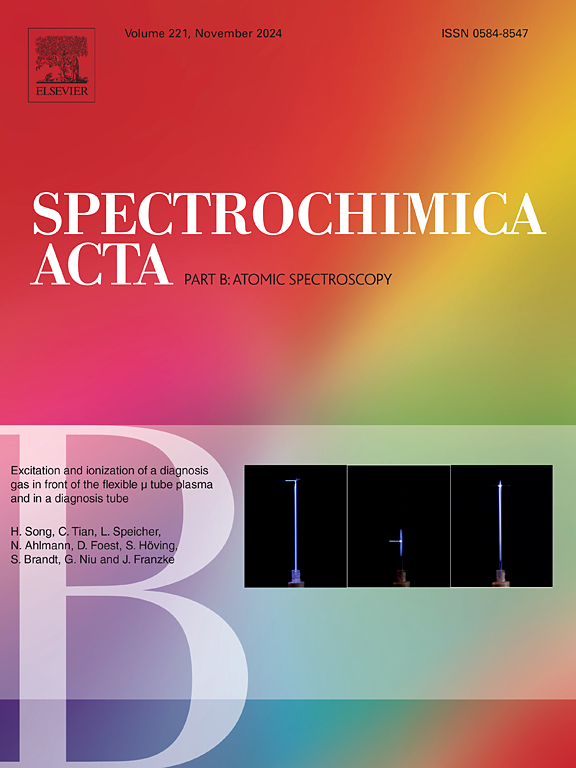应用便携式x射线荧光光谱和厚度监测仪对铁和锌锈层进行现场分析
IF 3.8
2区 化学
Q1 SPECTROSCOPY
引用次数: 0
摘要
本文提出了一种利用x射线荧光(XRF)光谱对钢锈和锌锈进行现场分析的新方法。该方法由薄膜模式分析组成,其中加入铁锈中的Cl−离子用作不受铁和氧含量影响的标记。利用便携式分析仪在多点同时监测锈层厚度,得到锈层厚度(t)与Cl含量(fCl)的关系图,表征锈层的性质。论证了对严重腐蚀钢和镀锌钢试样进行激光局部除锈的可行性。t- fCl曲线的斜率表示Cl的去除效率。对于非常薄的残余锈,通过在纯水中溶解氯化物的电阻率测量得到Cl含量与表面Cl密度的关系表明,XRF测量的表观Cl含量为0.4%对应于50 mg/m2的盐密度。本文章由计算机程序翻译,如有差异,请以英文原文为准。

Application of portable X-ray fluorescence spectroscopy and thickness monitor to characterize iron and zinc rust layer for on-site analysis
We propose a new method for on-site analysis of steel rust and Zn rust by exploiting X-ray fluorescence (XRF) spectroscopy. This method consists of a thin-film mode analysis in which Cl− ions incorporated in rust are used as a marker unaffected by the iron and oxygen content. By simultaneously monitoring the thickness of the rust layer with a portable analyzer at multiple points, a diagram of rust thickness (t) versus Cl content (fCl) is obtained to characterize the properties of the rust. The feasibility is demonstrated for severely corroded steel and galvanized steel samples after partial derusting by laser irradiation. The slope of the t- fCl plot represents Cl removal efficiency. For very thin residual rust, the relation between Cl content and surface Cl density derived by a resistivity measurement through solving chlorides in pure water indicated that an apparent Cl content of 0.4 % measured by XRF corresponds to a salt density of 50 mg/m2.
求助全文
通过发布文献求助,成功后即可免费获取论文全文。
去求助
来源期刊
CiteScore
6.10
自引率
12.10%
发文量
173
审稿时长
81 days
期刊介绍:
Spectrochimica Acta Part B: Atomic Spectroscopy, is intended for the rapid publication of both original work and reviews in the following fields:
Atomic Emission (AES), Atomic Absorption (AAS) and Atomic Fluorescence (AFS) spectroscopy;
Mass Spectrometry (MS) for inorganic analysis covering Spark Source (SS-MS), Inductively Coupled Plasma (ICP-MS), Glow Discharge (GD-MS), and Secondary Ion Mass Spectrometry (SIMS).
Laser induced atomic spectroscopy for inorganic analysis, including non-linear optical laser spectroscopy, covering Laser Enhanced Ionization (LEI), Laser Induced Fluorescence (LIF), Resonance Ionization Spectroscopy (RIS) and Resonance Ionization Mass Spectrometry (RIMS); Laser Induced Breakdown Spectroscopy (LIBS); Cavity Ringdown Spectroscopy (CRDS), Laser Ablation Inductively Coupled Plasma Atomic Emission Spectroscopy (LA-ICP-AES) and Laser Ablation Inductively Coupled Plasma Mass Spectrometry (LA-ICP-MS).
X-ray spectrometry, X-ray Optics and Microanalysis, including X-ray fluorescence spectrometry (XRF) and related techniques, in particular Total-reflection X-ray Fluorescence Spectrometry (TXRF), and Synchrotron Radiation-excited Total reflection XRF (SR-TXRF).
Manuscripts dealing with (i) fundamentals, (ii) methodology development, (iii)instrumentation, and (iv) applications, can be submitted for publication.

 求助内容:
求助内容: 应助结果提醒方式:
应助结果提醒方式:


